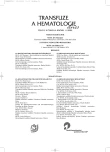Hodgkin’s lymphoma therapy results with a view to the treatment of relapses and primary progression
Výsledky léčby Hodgkinova lymfomu se zaměřením na léčbu relapsů a primárně progresivních onemocnění
Od ledna 1996 do září 2004 bylo na II. interní klinice – OKH FN v Hradci Králové léčeno pro Hodgkinův lymfom 128 pacientů – 62 mužů a 66 žen s mediánem věku 30 let (rozmezí 17–74). Jako primární léčba byla zvolena chemoterapie (29 %), chemoterapie s radioterapií (69,5 %) a radioterapie (1,5 %). Retrospektivně byla zhodnocena léčba celé skupiny pacientů (n = 128) a poté vyčleněné skupiny pacientů s relapsem a primární progresí (n = 29). Medián doby sledování souboru pacientů byl 41 měsíců (rozmezí 4–107). Průběh pravděpodobností přežití byl hodnocen podle metody Kaplan-Meiera, k porovnávání byl použit logrank test. Primární léčbou bylo dosaženo 111 kompletních remisí (87 %), z toho u 12 pacientů (11 %) došlo k relapsu. U 17 pacientů (13 %) onemocnění během primární léčby progredovalo. 62 % pacientů s relapsem a/nebo primární progresí bylo léčeno vysokodávkovanou chemoterapií s následnou autologní transplantací periferních kmenových buněk. Pravděpodobnosti 4letého celkového přežití a přežití bez známek onemocnění celého souboru jsou 92 % a 86 %. Statisticky signifikantně delší je celkové přežití pacientů s dosažením kompletní remise oproti pacientům bez dosažení kompletní remise po primární léčbě (p < 0,001). Celkové přežití pacientů s relapsem je delší než pacientů s primární progresí (p = 0,002). Úspěšnost léčby Hodgkinova lymfomu závisí na určení optimální intenzity primární léčby stanovené dle individuální prognózy, kdy zásadním krokem je stanovení správného stadia onemocnění v době diagnózy.
Klíčová slova:
Hodgkinův lymfom, primární progrese, relaps, chemoterapie, radioterapie, autologní transplantace periferních kmenových buněk
Authors:
A. Sýkorová 1; D. Belada 1; V. Maisnar 1; J. Voglová 1; P. Žák 1; L. Smolej 1; J. Bukač 2; J. Malý 1
Authors‘ workplace:
II. interní klinika – Oddělení klinické hematologie, Lékařská fakulta Univerzity Karlovy a Fakultní nemocnice, Hradec Králové
1; Ústav lékařské biofyziky, Lékařská fakulta Univerzity Karlovy, Hradec Králové
2
Published in:
Transfuze Hematol. dnes,11, 2005, No. 2, p. 40-46.
Category:
Comprehensive Reports, Original Papers, Case Reports
Overview
Between January 1996 and September 2004, 128 adult patients with Hodgkin’s lymphoma were treated at the Department of Clinical Haematology in Hradec Kralove. The group included 62 males and 66 females with median age 30 years (range, 17–74). Primotherapy of choice was chemotherapy alone (29 %), chemotherapy and radiotherapy (69.5 %) and radiotherapy alone (1.5 %). All patients (n = 128) and group of patients with primary progression and/or relapse (n = 29) were evaluated retrospectively. The median of the follow up was 41 months (range, 4–107). For survival analysis, Kaplan-Meier method was used, significance was tested using the logrank test. 111 patients (87 %) achieved complete remission after primotherapy, 12 patients (11 %) subsequently relapsed. The failure of primotherapy (primary progression) was observed in 17 patients (13 %). 62 % patients with primary progression and relapse were treated with high-dose chemotherapy followed by autologous stem cell transplantation. The probabilities of 4-year overall survival and disease free survival are 92 % and 86 %. The group of patients who achieved complete remission after chemotherapy had significantly longer overall survival (p < 0.001). Longer overall survival was also observed in patients with relapse vs primary progression (p = 0.002). The success of lymphoma therapy depends on accurate staging to determine the patient’s individual prognosis and select direct the most effective and least toxic treatment.
Key words:
Hodgkin’s lymphoma, primary progression, relapse, chemotherapy, radiotherapy, autologous stem cell transplantation
Labels
Haematology Internal medicine Clinical oncologyArticle was published in
Transfusion and Haematology Today

2005 Issue 2
- Cost Effectiveness of FVIII Substitution Versus Non-Factor Therapy for Hemophilia A
- Vascular Disease in the Gradually Aging Population of Hemophiliacs: An Underestimated Problem?
- Prognostic Significance of Subclinical Joint Changes on MRI in Hemophilia
- Immunotolerance is still the goal of management of hemophilia A with inhibitor in the era of non-factor therapy
- Minimum and Optimal Factor Levels in Physically Active Hemophiliacs
Most read in this issue
- Hodgkin’s lymphoma therapy results with a view to the treatment of relapses and primary progression
- Clinical significance of the evaluation of serum levels of immunoglobulin free light chains in monoclonal gammapathies
- LIFE 18 – the first contact with an integrated device for treatment by means of immunoadsportion
- Selection of blood donors for the multicomponent blood collection
